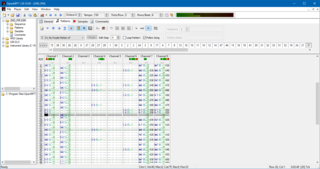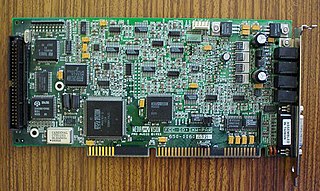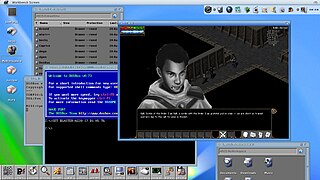
A sound card is an internal expansion card that provides input and output of audio signals to and from a computer under control of computer programs. The term sound card is also applied to external audio interfaces used for professional audio applications.

A music tracker is a type of music sequencer software for creating music. The music is represented as discrete musical notes positioned in several channels at discrete chronological positions on a vertical timeline. A music tracker's user interface is usually number based. Notes, parameter changes, effects and other commands are entered with the keyboard into a grid of fixed time slots as codes consisting of letters, numbers and hexadecimal digits. Separate patterns have independent timelines; a complete song consists of a master list of repeated patterns.

The Commodore Amiga 4000, or A4000, is the successor of the A2000 and A3000 computers. There are two models, the A4000/040 released in October 1992 with a Motorola 68040 CPU, and the A4000/030 released in April 1993 with a Motorola 68EC030.
Steinberg Media Technologies GmbH is a German musical software and hardware company based in Hamburg with satellite offices in Siegburg and London. It develops music recording, arranging and editing software, notably Cubase and Nuendo. It also designs audio recording and MIDI hardware interfaces and controllers and iOS music apps including Cubasis. Steinberg created several industry standard music technologies including the Virtual Studio Technology (VST) format for plug-ins and the ASIO protocol. Steinberg is a wholly owned subsidiary of Yamaha.

A digital audio workstation (DAW) is an electronic device or application software used for recording, editing and producing audio files. DAWs come in a wide variety of configurations from a single software program on a laptop, to an integrated stand-alone unit, all the way to a highly complex configuration of numerous components controlled by a central computer. Regardless of configuration, modern DAWs have a central interface that allows the user to alter and mix multiple recordings and tracks into a final produced piece.
Wzonka-Lad is a Nintendo Game Boy emulator for the Amiga series of home computers.

The XAD system is an open-source client-based unarchiving system for the Amiga. This means there is a master library called xadmaster.library which provides an interface between the client and the user application and there are clients handling the special archive formats. Three different types to handle file and disk archives and also disk image files (filesystem) are possible. They can be made by anyone. The master library itself includes some of these clients internally to make the work somewhat easier for the package maintainer and the user installing it.
Aladdin4D is a computer program for modeling and rendering three-dimensional graphics and animations, currently running on AmigaOS and Mac OS X platforms. A-EON Technology Ltd owns the rights and develops current and future versions of Aladdin4D for AmigaOS, MorphOS & AROS. All other platforms including OS X, iOS, Windows & Linux are developed by DiscreetFX.

The SiS 630 and SiS 730 are a family of highly integrated chipsets for Intel and AMD respectively. At the time of release they were unique in that they not only provided VGA, Audio, LAN, IDE and USB functionality on board, but were also in a single-chip solution. At the time of release (1999) most chipsets were composed of physically separate north-bridge and south-bridge chips. Only later have single-chip solutions become popular in the mainstream, with chipsets such as the nVidia nForce4.

The Media Vision Pro AudioSpectrum family of personal computer sound cards included the original 8-bit Pro AudioSpectrum (1991), the 8-bit Pro AudioSpectrum Plus, 16-bit Pro AudioSpectrum 16, Pro AudioSpectrum 16 Basic and 16-bit Pro Audio Studio. All PAS cards with the exception of Pro AudioSpectrum 16 Basic could connect to CD-ROM drives—variants having SCSI or various proprietary interfaces—and many were sold in multimedia kits with compatible CD-ROM drives.
ReAction GUI is the widget toolkit engine that is used in AmigaOS 3.5-4.1.
CDXL is an obsolete motion video file format developed by Commodore in the late 1980s and early 1990s for the Amiga computer platform. It is notable for being one of the earliest formats created for motion video playback from CD-ROM.
WarpOS is a multi-tasking kernel for the PowerPC architecture developed by Haage & Partner for the Amiga computer platform in the late 1990s and early 2000s. It runs on PowerUP accelerator boards developed by phase5 which contains both a Motorola 68000 family CPU and a PowerPC CPU with shared address space. WarpOS runs alongside the 68k-based AmigaOS, which can use the PowerPC as a coprocessor. Despite its name, it is not an operating system (OS), but a kernel; it supplies a limited set of functions similar to those in AmigaOS for using the PowerPC. When released its original name was WarpUP, but was changed to reflect its greater feature set, and possibly to avoid comparison with its competitor, PowerUP.
Kickstart is the bootstrap firmware of the Amiga computers developed by Commodore.
The Amiga 1200, or A1200, is Commodore International's third-generation Amiga computer, aimed at the home computer market. It was launched on October 21, 1992, at a base price of £399 in the United Kingdom and $599 in the United States.
Warp3D was a project, founded by Haage & Partner in 1998, that aimed to provide a standard API which would enable programmers to access, and therefore use, 3D hardware on the Amiga.

PowerUP boards were dual-processor 68k–PowerPC accelerator boards designed by Phase5 Digital Products for Amiga computers. They had two different processors working in parallel, sharing the complete address space of the Amiga computer system.
Retargetable graphics is a device driver API mainly used by third-party graphics hardware to interface with AmigaOS via a set of libraries. The software libraries may include software tools to adjust resolution, screen colors, pointers, and screenmodes. It will use available hardware and will not extend the capabilities in any way.








